Satisfy your sushi craving with this Salmon Sashimi Bowl! Steamed Japanese rice topped with fresh sashimi-grade salmon, briny salmon roe (ikura), and crispy nori seaweed, this donburi bowl is light and super tasty. It’s also one of the quickest fancy dinners that you can put together.
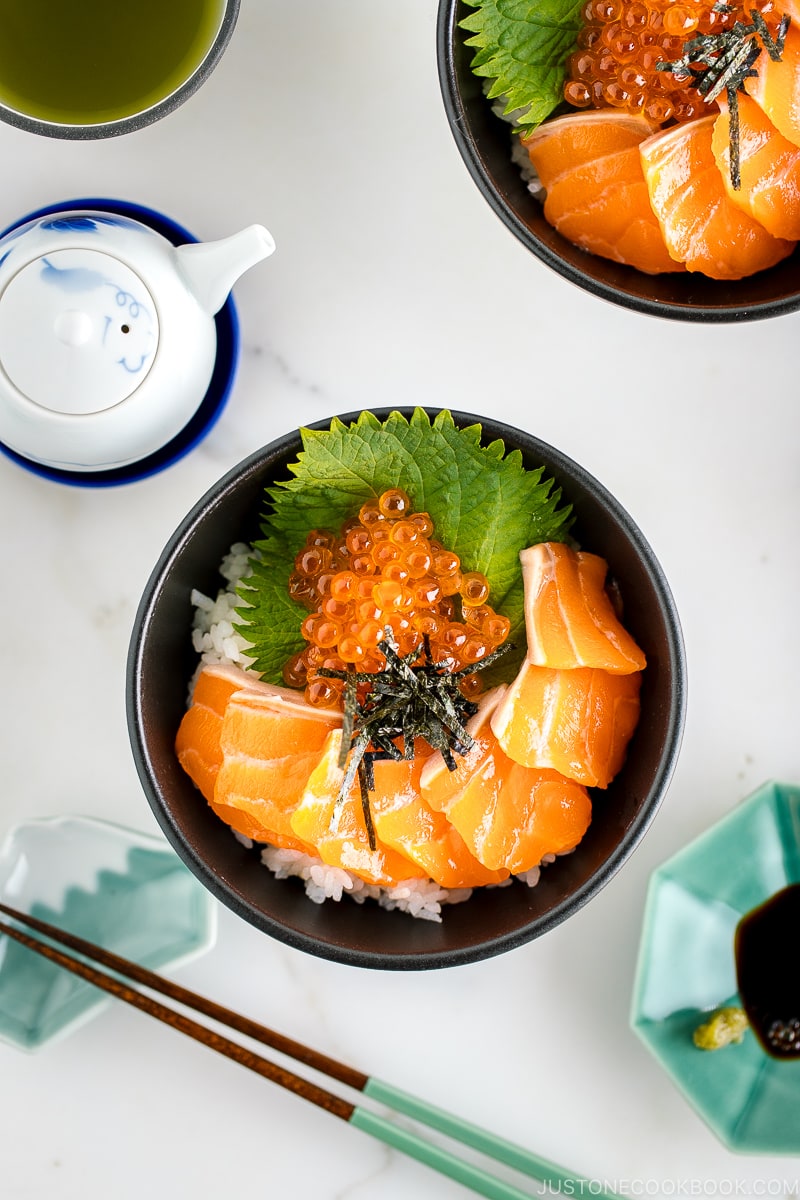
Sushi and sashimi always make a real treat for seafood lovers. While they may be the kind of foods you rather enjoy at a Japanese restaurant, at home, you can make this Salmon Sashimi Bowl with Ikura (鮭いくら丼).
A bowl of steamed rice, topped with pure luxury from the ocean, this Japanese rice bowl turns out to be one of the easiest dishes imaginable.
Satisfy Your Sushi Cravings!
These days you can enjoy fresh sashimi-grade seafood without a trip to a sushi restaurant or Japanese grocery store. You just need to know where to source them or have them delivered straight to your home.
When my family has a craving for sushi, I often resolve it by making this Salmon Sashimi Bowl. It’s extremely quick, refreshing, yet fancy. The robust flavor of fresh salmon and rich saltiness of ikura roe, when enjoyed with the tender sweet rice, you know you’re in for a heavenly indulgence. Best of all, enjoying seafood at home is so much more economical than eating out.
The sashimi bowl is, of course, more of a concept than a real recipe. What you need to do is to cook rice, assemble all the ingredients, and serve.
Quick and Easy Meal Ready in 10 Minutes!
As long as you have the rice cooked in advance, it really doesn’t take much to prepare:
- Make sure the rice is cooked ahead (whether scheduled in your rice cooker or ready to reheat from the freezer). Otherwise, just make steamed rice using your method. The rice cooking time is not counted for the total preparation time.
- Slice salmon. Read my tips below.
- Serve steamed rice, and let it cool off slightly. Meanwhile, you can set up other toppings.
- Assemble salmon sashimi, ikura, shiso leaves, and shredded nori on top. Serve with soy sauce!
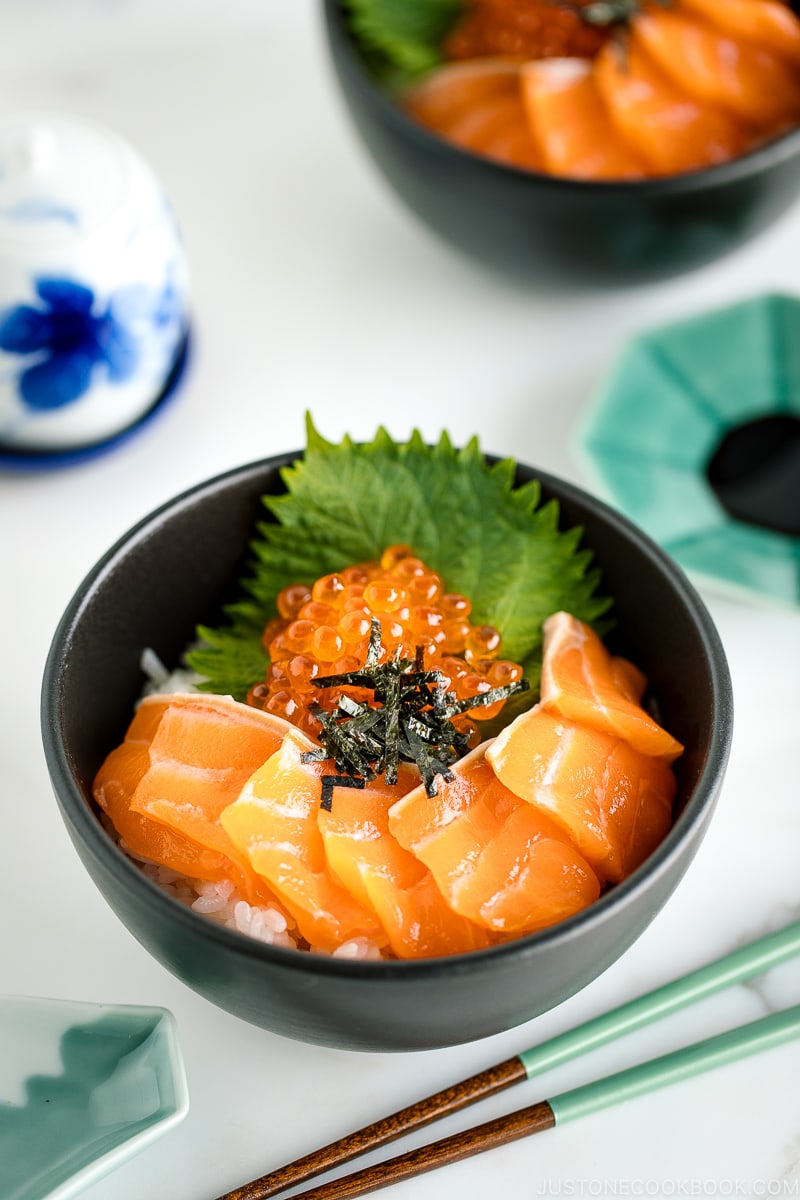
Where to Get Sashimi-Grade Salmon and Ikura (Salmon Roe)
If you live near a Japanese grocery store, I recommend checking out their sashimi selections. Here, where I live, Japanese grocery stores Nijiya and Suruki in San Mateo are my go-to stores.
Don’t live near a Japanese grocery store? You have the option of shopping at online sashimi stores in the US, such as Catalina Offshore. More information after the recipe card in the post.
Sashimi Slicing Tips
There are a few tips for slicing salmon sashimi that has worked for us.
- Place the salmon block in the freezer for 5-10 min before slicing. This will firm up the flesh so it’s easier to slice.
- You don’t need a sashimi knife but make sure to use a really sharp knife. Do not use a serrated knife to slice sashimi.
- The simplest way to slice salmon sashimi is to cut the fish vertically. Pulling the knife towards you, start the cut from the base of the knife to the tip. This method is called hira-zukuri.
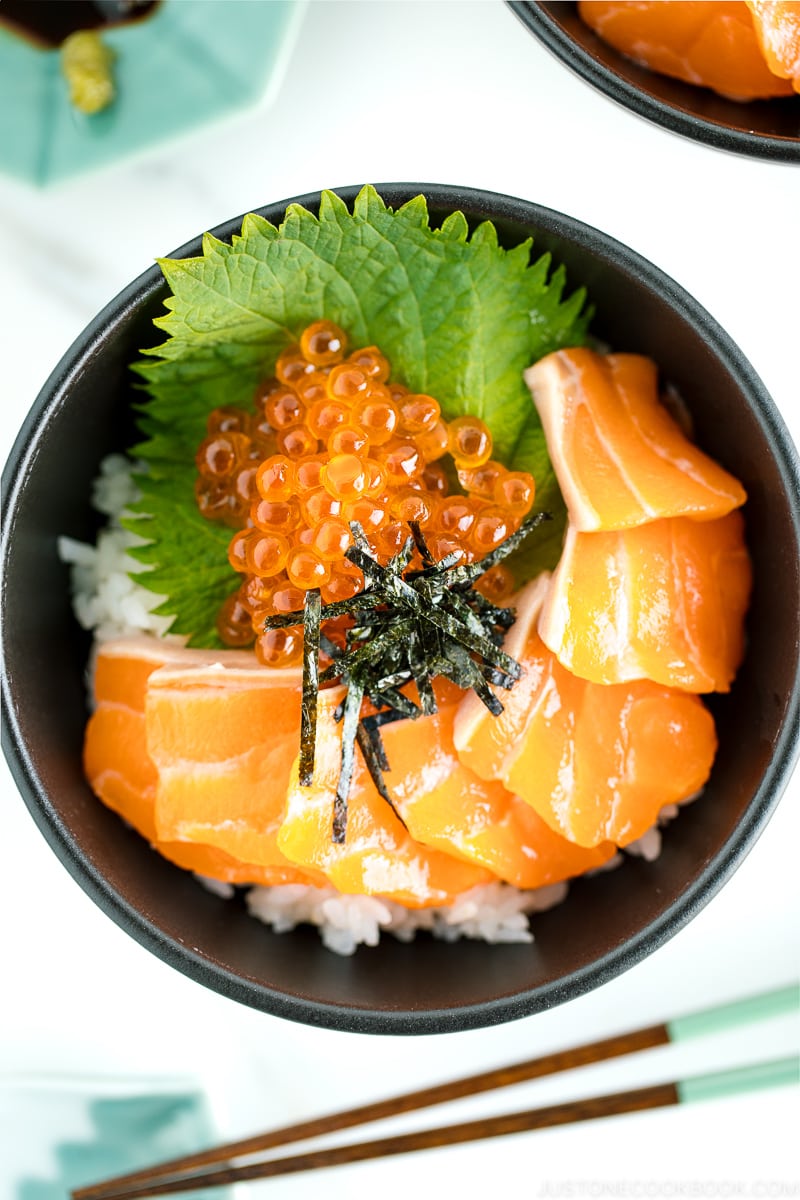
Steamed Rice or Vinegared Sushi Rice
Considering this rice bowl is served with sashimi, you may wonder if we have to use “sushi rice”, which is steamed rice that’s seasoned with sweet vinegar or sushi vinegar.
In Japan, we serve simple steamed rice whenever a dish is called “Donburi (丼ぶり)” or “Don (丼)” for short. However, when the sashimi is served over the rice and it’s called “sushi”, then the steamed rice is always seasoned.
Having said that, you’re the one who decides when cooking and eating at home. For this “Salmon and Ikura Donburi” recipe, I served it with plain steamed rice. But feel free to serve with sushi rice. You can find my sushi rice tutorial here.
Use Sashimi/Sushi-Grade Salmon
Use only sashimi-grade salmon for raw consumption. Some salmon contains parasites and here are the FDA guidelines for destroying the parasites:
Freezing and storing at an ambient temperature of -4°F (-20°C) or below for 7 days (total time), or freezing at an ambient temperature of -31°F (-35°C) or below until solid and storing at an ambient temperature of -31°F (-35°C) or below for 15 hours, or freezing at an ambient temperature of -31°F (-35°C) or below until solid and storing at an ambient temperature of -4°F (-20°C) or below for 24 hours are sufficient to kill parasites.
FDA guidelines
I hope this quick and easy Salmon Sashimi Bowl inspires you! If you’re not a salmon fan, try it with your other favorite raw fish such as tuna, hamachi, or sweet crab meat.
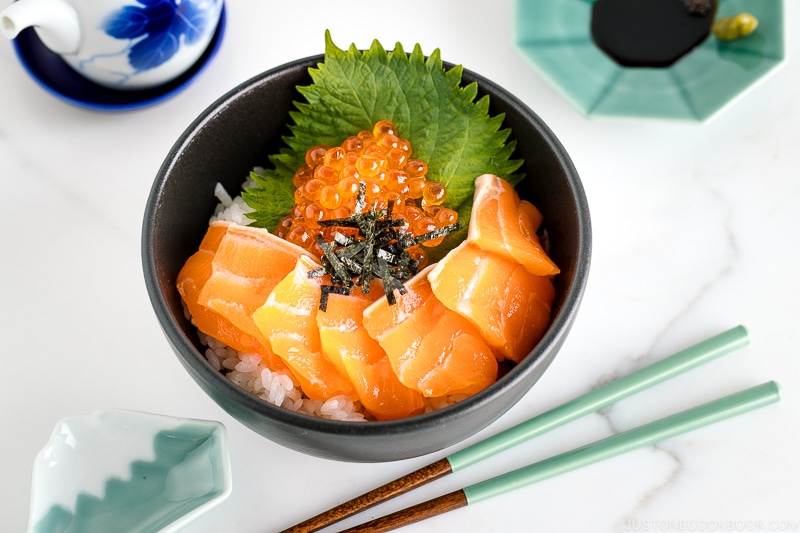
Wish to learn more about Japanese cooking? Sign up for our free newsletter to receive cooking tips & recipe updates! And stay in touch with me on Facebook, Pinterest, YouTube, and Instagram.
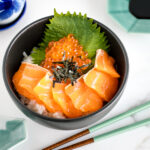
Salmon Sashimi Bowl (Donburi) with Ikura
Ingredients
- 2 servings cooked Japanese short-grain rice (typically 1⅔ cups (250 g) per donburi serving)
- 5 oz sashimi-grade salmon
- 3 Tbsp ikura (salmon roe)
For the Toppings (optional)
Instructions
- Before You Start: Gather all the ingredients. For the steamed rice, please note that 1½ cups (300 g, 2 rice cooker cups) of uncooked Japanese short-grain rice yield 4⅓ cups (660 g) of cooked rice, enough for 2 donburi servings (3⅓ cups, 500 g). See how to cook short-grain rice with a rice cooker, pot over the stove, Instant Pot, or donabe.
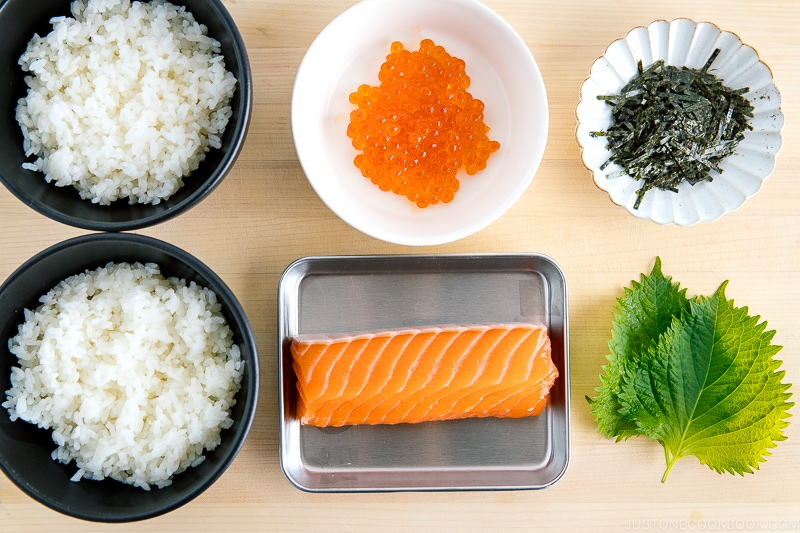
- With a very sharp knife, slice 5 oz sashimi-grade salmon. Remove the stems of 2 shiso leaves (perilla/ooba).
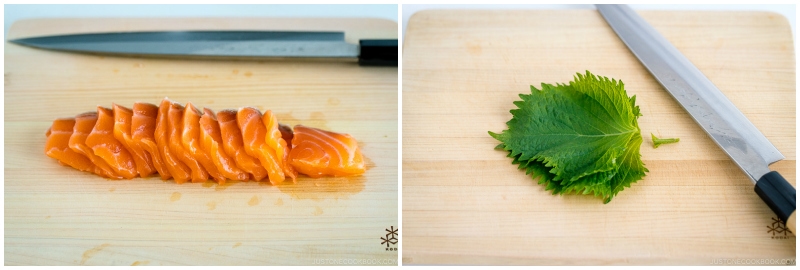
- Divide 2 servings cooked Japanese short-grain rice into individual (large) donburi bowls and let it cool slightly. You do not want the hot rice to cook the sashimi. Then, layer the slices of salmon on the rice like flower petals until you cover half of the rice. Place one shiso leaf in each bowl to cover the other half of the rice. Divide 3 Tbsp ikura (salmon roe) and add on top of each leaf. Garnish the bowls with 2 Tbsp shredded nori seaweed (kizami nori). Serve soy sauce in a small dish and put wasabi on the side. Mix the sauce and drizzle on top of the Salmon Sashimi Bowl to enjoy!
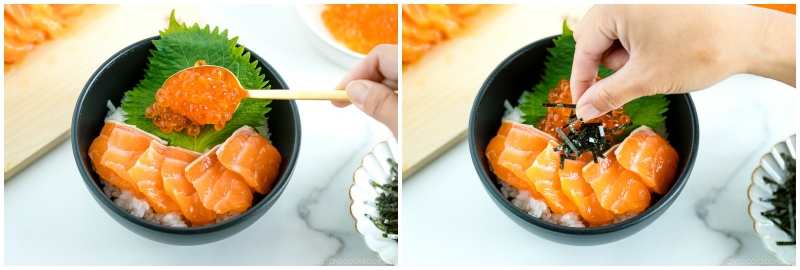
Nutrition
Editor’s Note: This post was originally published on October 7, 2011. New images have been added in September 2020.
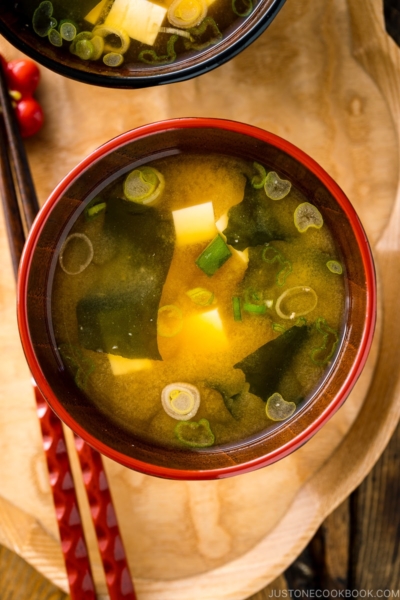
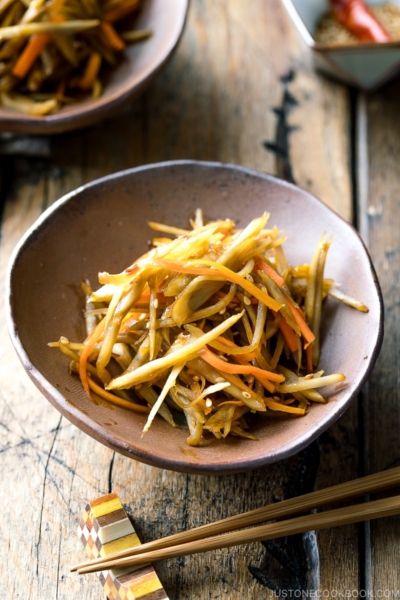
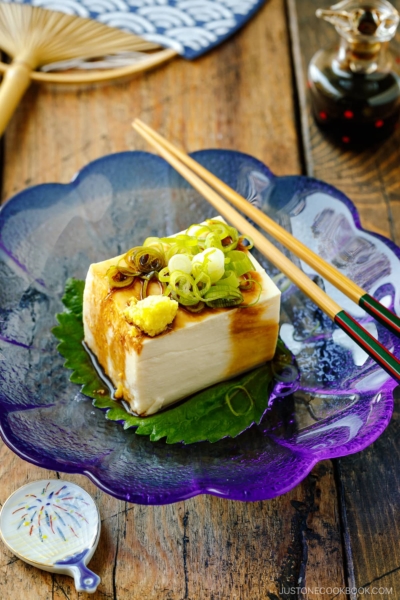
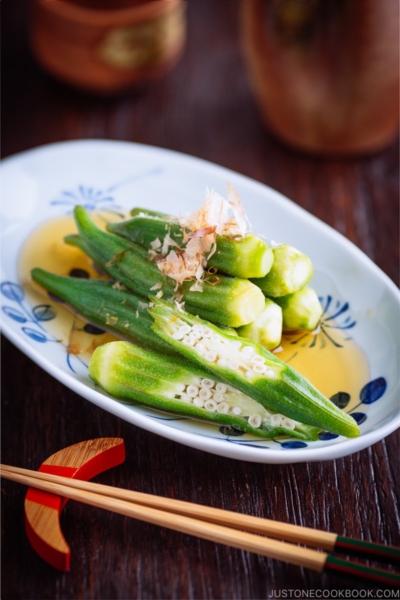




Konnichiwa Namiko-San, Boy, does that look good! I see you have a nice sashimi knife. Good for you.
Hi Guy cabral, Thank you very much for reading Nami’s post and for your feedback!
Are you interested in knives? Here is a recommended post for you.
https://www.justonecookbook.com/your-guide-to-japanese-knives/
We hope you enjoy it.
Where do you get sashimi grade fish?
Hi Nyle! I get it from a local Japanese grocery store Nijiya. We have several Japanese grocery stores around here as well as some good online sashimi shop like this one: https://www.absseafood.com/.
Thank you!! ❤
Hello Nami,
Thank you for sharing this fabulous recipe. This week, I’ll be making this for the first time. It’s my favourite and I was surprised to see the recipe here. I have most of the ingredients; just have to order sashimi grade salmon, ikura and shiso leaves then I’m good to go. Will let you know. Thank you once again.
Hi Sofia! Enjoy! We’re making this for dinner too. 😀
Hi Nami
I am so going to make this very soon. I will have to make sure the raw salmon is fresh and safe enough for my 3 year old son to eat (he would want some when he sees me eating this, for sure!) Thanks for sharing the tips.
Hi Sofia! Make sure you know the source of sashimi-grade fish. 🙂 Hope your family enjoy the meal!
Thanks for the recipe for the Salmon and Ikura Don. Is the fresh Salmon filet used for this dish frozen in a commercial freezer and defrosted before being used for this dish to eliminate the fish parasite, D. latum that is naturally carried by Salmon that migrate up fresh water streams to spawn? The FDA states that the freezer temperature in home refrigerators is not cold enough to kill the parasite. I have gone fishing to Alaska and have brought back wild caught Coho (Silver) Salmon and but have never eaten Salmon sashimi. I have a personal history of being infected with the D. latum parasite confirmed by clinical lab tests of the proglottid segments and ova of the Salmon after consumption of undercooked fresh wild salmon that was caught and personally brought back in individually vacuum packed frozen filets. I have never had any problems with the consumption of ikura because I learned to prepare the ikura using the freshly harvested salmon eggs that have been carefully washed in a measured salt water solution and marinated in Sake Kasu and Sake for at least one week.
Hi Edwin!
I do not use fresh salmon filet. It’s salmon that’s been processed specifically for sashimi used. As my friend Marc Matsumoto shared on pbs.org, FDA provides guidance under their Parasite Destruction Guarantee. This states in part that fish intended to be consumed raw must be “frozen and stored at a temperature of -20°C (-4°F) or below for a minimum of 168 hours (7 days)”.
http://www.pbs.org/food/fresh-tastes/myth-sushi-grade/
http://www.fda.gov/Food/GuidanceRegulation/RetailFoodProtection/FoodCode/ucm186451.htm#part3-4 (See under “Freezeing”)
Hi Nami, wanted to tell you that I made this as soon as I got the salmon from your online store. Well, as soon as I got the piece defrosted 🙂 The salmon was so delicious and a complete hit with us. My husband is a huge fan of salmon and ikura and we both loved this donburi recipe!
Hi Janice! Thank you for your feedback! I’m happy to hear you enjoyed the salmon! We always have this salmon in our freezer and make this when I’m too busy to cook. 🙂 I really appreciate for your time to write feedback. Thank you!!
Please teach me how to cook sukiyaki beef, thanks
Hi Sherilyn! Sukiyaki recipe is here: https://www.justonecookbook.com/recipes/sukiyaki/
Hope you enjoy! 🙂
Hi Nami,
We’re big on rice here in Singapore but we use Thai rice instead. I’ve had my fair share of Japanese donburi at Japanese restaurants here and can say that the taste and texture of Japanese rice is different. Is the difference in taste attributed solely to the fact that Japanese rice was used?
Or is there a different method or ingredient to cook Japanese rice?
Hi Tan! Yeah it is different, including fragrance too. Unless it’s for sushi, maybe the texture doesn’t affect too much (if you put something over rice (donburi) or fried rice or simply eat with steamed rice). However, if it’s for sushi or rice ball (onigiri), short grain Japanese rice is highly recommended because it requires certain texture and Thai rice is not optimal for that.
I have a post about how to make rice in a rice cooker and in a pot, so you can take a look how we prepare rice, but this doesn’t really change texture/flavor. Hope this helps. 🙂
https://www.justonecookbook.com/how-to/how-to-make-rice/ (in rice cooker)
https://www.justonecookbook.com/recipes/how-to-cook-rice/ (in pot)
Is the salmon filet/sashimi that you use for the salmon and ikura don pre-frozen at -10 deg C for 24-48 hours (this is the minimum temperature that is necessary to kill the fish tapeworm ( D. latum) when consuming fresh salmon). I love to eat sashimi but do not eat salmon sashimi because I have a history of eating undercooked fresh salmon caught in Alaska, and was diagnosed with a clinical case of fish tapeworm. 4 out of 5 cases with fish tapeworm are asymptomatic but I was able to identify expelled segments the fish tapeworm because of my background in microbiology and was able to refer myself for proper medical diagnosis and treatment. You can use me as an example to warn and educate the readers of your blog about the hazards of eating
“salmon sashimi.” “Lomi” salmon is a simple side dish made with salted raw salmon mixed with diced onions and tomatoes used in Hawaiian Luaus. It is requirement that only defrosted frozen salmon be used to make this dish to eliminate exposure to the fish parasite.
Hi Edwin! Thank you for the comment! The salmon filet I use or sell at FishforSushi.com (my online store) are all previously frozen and stored at a temperature much lower than -10 degree C for over 5 days. 🙂 Thank you for your information!